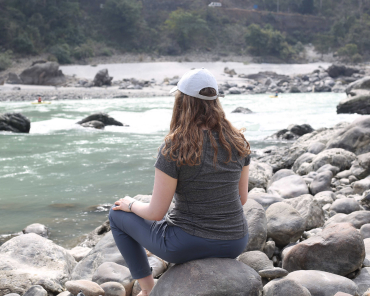
Becoming a certified yoga teacher was once something that required travel, long-term commitment, and often relocating to spiritual hubs like Rishikesh or Bali. Today, things have changed, yoga teacher training is more accessible than ever, thanks to the rise of online programs.
But with all these options, how do you decide what’s right for you? Should you go for in person yoga teacher training and soak in the real-time ashram or retreat vibe? Or is an online yoga teacher training enough to launch your teaching journey from the comfort of home?
This guide is here to help you weigh both options with clarity. Whether you’re a working professional, a student, or a wellness enthusiast, we’ll walk you through the pros, cons, formats, and experiences of both online and in-person yoga teacher training so you can make a confident choice.
What Is Online Yoga Teacher Training?
Online yoga teacher training refers to a structured program conducted virtually, usually over Zoom, pre-recorded videos, or online learning platforms. These programs are designed to offer flexibility, allowing students to learn at their own pace or join live sessions based on a fixed schedule.
Most online YTT courses are still Yoga Alliance certified, which means you can become a registered yoga teacher (RYT-200 or RYT-300) even from your living room. These courses typically include asana instruction, anatomy lessons, yoga philosophy, teaching methodology, and assignments, all delivered digitally.
The best part? No need to travel, take extended leave, or uproot your daily routine. Online yoga teacher training is ideal if:
You have work or family commitments.
You prefer learning at your own pace.
You want a more affordable path to certification.
But it’s not just about convenience, it’s also about accessibility. Online training has opened doors for people across the globe to learn from top teachers without geographic limitations.
What Is In-Person Yoga Teacher Training?
On the flip side, in person yoga teacher training is the traditional and immersive format where students travel to a physical location, usually a yoga school, retreat center, or ashram, to undergo a residential or intensive training experience.
If you’re someone who learns best in real-time, enjoys group energy, or wants to fully disconnect from daily life and dive deep into yogic practice, this format might be perfect for you.
During yoga teacher training in person, students typically follow a daily schedule that includes:
- Morning meditation and pranayama
- Asana practice and adjustments
- Philosophy and anatomy classes
- Teaching practice (practicum)
- Community meals and group discussions
The environment itself often plays a big role in the transformation. Picture this: chanting by the Ganges, sharing meals with fellow trainees, asking your teacher questions face-to-face, and experiencing the depth of yoga beyond just postures.
The best in person yoga teacher training programs are known for offering life-changing experiences, not just certifications. However, they do require:
A fixed time commitment (usually 3–5 weeks)
Travel and accommodation arrangements
A willingness to unplug and fully immerse
Read More: Why Is Kundalini Yoga Dangerous? The Truth About Its Risks and Rewards
Online Yoga Teacher Training vs In-Person – A Side-by-Side Comparison
Choosing between online yoga teacher training vs in-person comes down to more than just convenience. Both paths offer unique experiences, and understanding the differences can help you align your decision with your lifestyle, learning preferences, and goals.
Here’s a quick breakdown to help you see the contrasts clearly:
Feature | Online Yoga Teacher Training | In-Person Yoga Teacher Training |
Learning Format | Self-paced videos or live Zoom sessions | Real-time, hands-on classes in a physical location |
Schedule Flexibility | High – study anytime, anywhere | Fixed schedule – typically full-day immersive training |
Teacher Interaction | Mostly virtual via email/Zoom | In-person corrections, feedback & mentorship |
Peer Community | Group chats, online forums | Stronger emotional bonding & shared journey |
Cost | Usually more affordable | Higher due to travel, food, and accommodation |
Certification Credibility | Often Yoga Alliance certified | Also Yoga Alliance certified, and often seen as more immersive |
Travel Requirement | None | Yes – often a retreat-like experience |
Whether you’re leaning toward the best in-person yoga teacher training or want the ease of studying from your living room, it’s about finding the format that aligns with your pace and purpose.
Pros & Cons of Online Yoga Teacher Training
Online yoga teacher training has opened doors for thousands of people across the world—but like all flexible formats, it comes with its strengths and limitations.
Pros:
- Flexible schedule: Learn at your pace, especially great for working professionals or parents.
- Budget-friendly: No travel, no boarding—just pay for the course and start.
- Global access: Train under renowned teachers from anywhere in the world.
- Replay value: Recorded sessions let you review complex lessons as many times as needed.
Cons:
- Limited physical adjustments: No in-person touch or real-time correction of posture.
- Motivation challenges: Without a group setting, it’s easier to postpone practice.
- Less immersive: You may miss the magic of a retreat or yogic community vibe.
Online training is ideal for self-disciplined learners who need flexibility without compromising on content quality.
Pros & Cons of In-Person Yoga Teacher Training
If you’re someone who learns best through hands-on guidance and group energy, an in-person yoga teacher training might be just what you need.
Pros:
- Real-time feedback: Teachers can immediately correct alignment and posture.
- Community bonding: You form deep connections with fellow trainees.
- Immersive experience: You live and breathe yoga—routine, food, philosophy, and lifestyle.
- Stronger presence: Great for building teaching confidence through live practice.
Cons:
- Higher cost: You’ll need to factor in travel, accommodation, and meals.
- Less schedule flexibility: Fixed dates and durations mean you need to commit fully.
- Location-bound: Not everyone can take a month off or travel internationally.
For many, yoga teacher training in person is a life-changing journey, both emotionally and physically.
How to Choose the Right Yoga Teacher Training Format for You
Still unsure? Here’s how to decide:
- Time: Do you have the ability to dedicate 3–4 weeks away from home? If not, online might suit you better.
- Budget: Consider your investment limit. Online is more affordable; in-person is an experience.
- Learning Style: If you thrive in community settings with real-time support, in-person wins. Prefer quiet, solo study? Online is your zone.
- Goal: Are you becoming a teacher or deepening your personal practice? Both formats serve well, but if you’re aiming to teach in physical studios, in-person yoga teacher training gives you an edge in practical teaching exposure.
No one format is better than the other, it’s about what fits your life right now.
Become a Certified Yoga Trainer in the Yoga Capital of the World
At Hari Om Yoga Vidya School, we invite you to begin your transformative journey in Rishikesh, widely regarded as the Yoga Capital of the World. Whether you’re just starting out or looking to deepen your practice, our globally recognized yoga teacher training courses offer the ideal foundation to grow into a confident, authentic yoga teacher.
As the best yoga school in Rishikesh, we offer a range of Yoga Alliance-certified training programs:
- 100-Hour Yoga Teacher Training – A perfect introductory course for those exploring the yogic path or short on time.
- 200-Hour Yoga Teacher Training – The most popular course to become a certified yoga trainer and start teaching worldwide.
- 300-Hour Yoga Teacher Training – For teachers who want to deepen their knowledge and refine their teaching skills.
Join a community of dedicated practitioners and world-class instructors in the serene heart of Rishikesh. This is more than a certification, it’s a journey toward self-discovery and meaningful transformation.
Start your path today with the best yoga teacher training in Rishikesh.
Conclusion: Listen to Your Intuition, Honor Your Journey
Whether you choose an online yoga teacher training or decide to immerse yourself in a yoga teacher training in person, you’re stepping into a deeply transformational space. Both paths offer wisdom, discipline, and the tools to teach from the heart.
Trust yourself. Choose what feels aligned today. Because no matter the format, what matters is that you begin.



